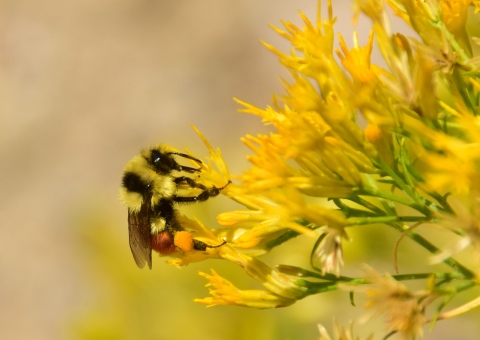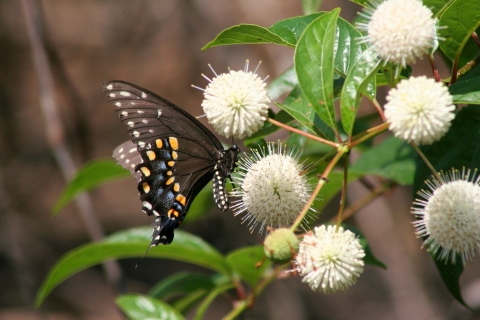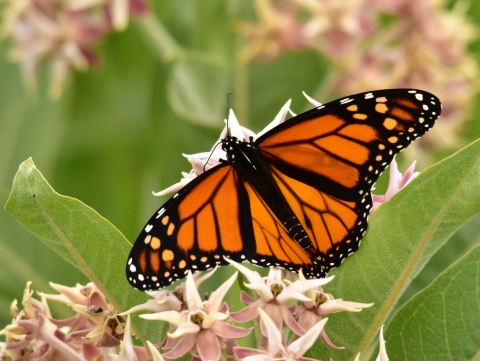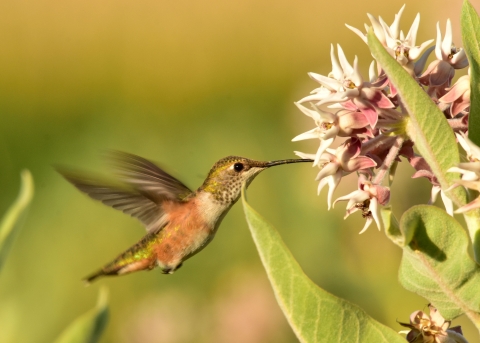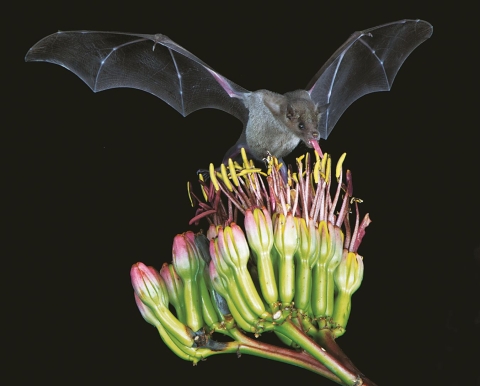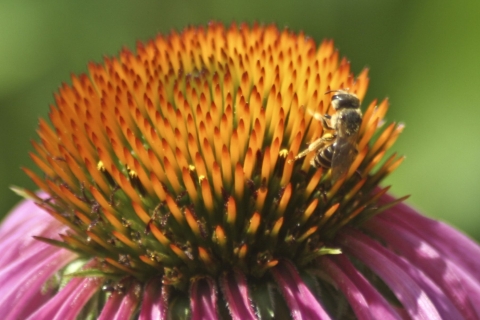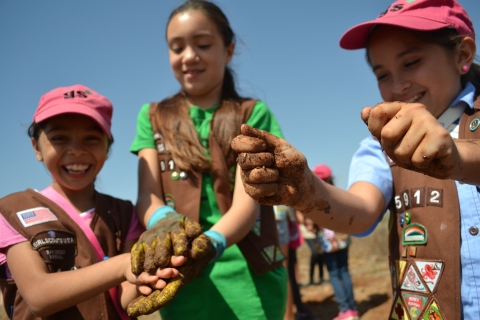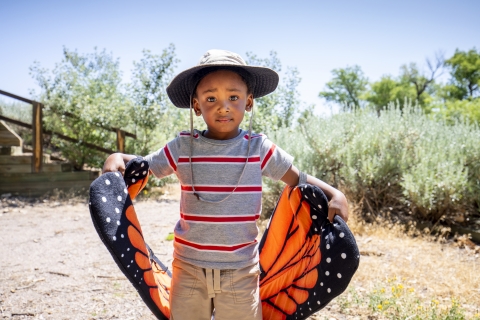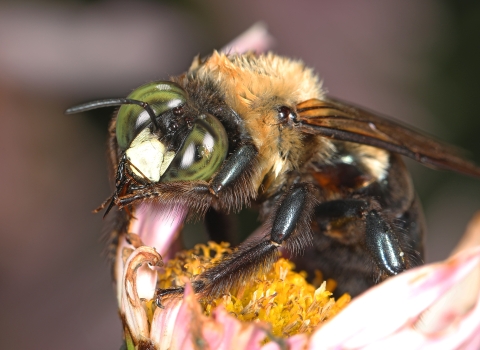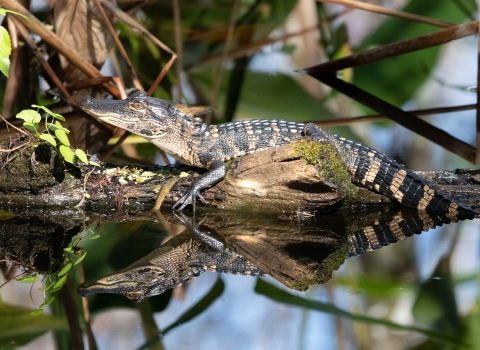You may not realize it, but we owe most of our fruits, crops and flowers to animals. Yes, animals. All day long in the growing season, insects and other creatures carry pollen from flower to flower, fertilizing them in the process and helping to feed the planet.
Oh, sure, wind and water carry pollen, too. But their role is tiny, compared to the work done on the wing. Bees lead the pack as living pollen transport units. Other important pollen carriers — or pollinators — include flies, butterflies, moths, beetles, hummingbirds and bats.
So consider: When you help feed pollinators, you help sustain the world.
Watch a stunning video on the beauty of pollination.
Remember how pollination works? (It’s okay. We needed a refresher, too.) A stalk-like structure structure
Something temporarily or permanently constructed, built, or placed; and constructed of natural or manufactured parts including, but not limited to, a building, shed, cabin, porch, bridge, walkway, stair steps, sign, landing, platform, dock, rack, fence, telecommunication device, antennae, fish cleaning table, satellite dish/mount, or well head.
Learn more about structure called the anther, located in the male part of a flower (called the stamen) makes pollen. For fertilization to occur, that pollen has to get to a flower’s female part, called the pistil (where seeds are made).
This is where a bee, bird, bat or other creature comes in. When the animal stops at a flower to feed on nectar or pollen, some pollen grains stick to its body. At the next flower stop, some of those grains brush off on the top of the pistil, called the stigma. Pollen grains on the stigma grow tubes down to the ovary, and fertilization begins. Mission accomplished.
Don’t worry. There’s no test. You can help feed pollinators even if you don’t remember the fine points of plant biology. Every effort counts.
See a video on flower pollination.
Bees are the ultimate pollinators — focused on their job and built for it, too. Other insects, while important to the process, move pollen more by chance.
“Bees are the only insects deliberately seeking pollen as a food; it’s their main source of protein,” explains Wedge Watkins, retired wildlife biologist at Big Muddy National Fish and Wildlife Refuge in Missouri. “All these other animals are visiting the flower to get at its nectar. In the process of that, they stick their face or some other body part into the flower and accidentally get pollen on them.”
Bumblebees have developed an ingenious method to get pollen: They shake it loose by vibrating at just the right frequency — called buzz pollination. Some bees are specialists – able to use pollen from only one kind of flower.
Most bees also stock their nests with pollen to feed their young. “They store it in a variety of places — on their legs and on their abdomen,” says Watkins. “They carry it back to the nest, mixed with nectar. They deposit it in ball shape and lay an egg on it. The egg develops into larva. The larva eats that pollen and pupates into an adult.”
Female bees do all the pollen gathering, and have hairy legs and abdomens adapted to the task. Male bees are thinner and much less hairy; their primary job is fertilizing the female and creating the next generation.
When you see bees buzzing in your wildflower garden – or around the flowers on your windowsill – it’s a sign things are going right.
For many Americans, the first warning sign that pollinators might be in trouble came from reports — beginning in 2006 or so — of losses of honeybee colonies. Although honeybees are not native pollinators (more on this below), they face some of the same stressors as other pollinators.
These include habitat loss, disease, parasites and increased pesticide use. One group of pesticides, called neonicotinoids, arouses particular concern. These, in wide use since the mid-1990s, make whole plants — including their nectar and pollen — toxic to insects.
In response to the bee-loss reports, the U.S. Agriculture Department began conducting annual surveys of honeybee colony health in 2009. USDA surveys showed that the number of managed U.S. honeybee colonies dropped from 5 million in 1945 to 2.5 million in 2014.
For people more focused on the health of native bees, the picture is less simple. “We have little or no population data on the 20,000 species of native bees in the world,” says Watkins. This includes the 4,000 or so species in the United States.
The monarch butterfly, beloved by many, has become a symbol of pollinators in trouble.
For decades, hundreds of millions of the familiar orange-and-black butterflies flooded the continental United States and southern Canada each spring and summer upon their return from Mexico. Their population has dropped by as much as 80 percent in recent years. That decline has coincided with the widespread loss of their host plant (milkweed) and nectar sources (wildflowers) and the increased use of neonicotinoids tied to agriculture and development.
The U.S. Fish and Wildlife Service is working with schools, communities and partners across the nation to plant more native milkweed and other nectar sources.
On December 15, 2020, the U.S. Fish and Wildlife Service announced that listing the monarch as endangered or threatened under the Endangered Species Act is warranted, but precluded by higher priority listing actions.
In the meantime, there are some things you can do to help.
One good first step: Plant some wildflowers. Even a pot of coneflowers can help.
“Making a space for wildflowers at any level is helpful to pollinators,” says Watkins. That holds true, he says, “whether you have a farm, a garden or you’re in an apartment in the city and setting out a pot of black-eyed Susans on your balcony or windowsill.”
While monarch caterpillars rely solely on milkweed for food, the adult butterflies feed on many different kinds of flowers. Ensure a continued nectar supply by planting a variety of flowering plants. Include plants that flower at different times of the growing season. Find out which plants are right for your part of the country.
Birds can be pollinators, too. In the continental United States, hummingbirds are especially important pollinators of wildflowers.
Hummingbirds seek out nectar-producing plants by color, not by smell. They’re attracted to the colors red, yellow and orange.
Perennial plants that attract hummingbirds include bee balms, columbines, trumpet creeper, daylilies, cardinal flower, sages and lupines.
Surprised? Don’t be. Bats are important pollinators, too. “More than 520 flowering plants depend on bats as pollinators,” says Micaela Jemison, former communications director for Bat Conservation International, a nonprofit dedicated to protecting the world’s 1,400-plus bat species. “Many species of bats have elongated snouts and long tongues specially adapted to eating and dispersing pollen.”
In the desert Southwest, the agave plant relies mainly on long-nosed bats to pollinate its flowers. The tequila industry relies on the bats, too; without agave reproduction, there would be no tequila.
Read more about bats as pollinators.
Read about some of the other animals that can be pollinators, too.
Honeybees are not native to North America. European settlers brought hives with them for honey production in the 1600s. Today, commercial honeybees play an important role in the production of many important crops.
But many see honeybee decline as a danger sign for native bees and other pollinators.
“The reality is that because honeybees are an agricultural commodity, they have political horsepower,” says Watkins. “Without the attention being paid to honeybees, we probably wouldn’t have attention being paid to native bees.”
In February 2017, Bombus affinis, aka the rusty-patched bumblebee, earned a dubious honor. It became the first bumblebee species to be listed as endangered under the Endangered Species Act.
Once abundant across 28 states, the rusty-patched bumblebee has declined dramatically since the late 1990s. Now, only a few small, scattered populations remain in nine states and one Canadian province.
Placing the bee under federal protection, said retired Service Regional Director Tom Melius, “will help us mobilize partners and focus resources on finding ways right now to stop the decline” and save the bee from extinction.
Restoring native habitat – including milkweed and wildflowers – comes naturally to national wildlife refuges. Refuge staff involve school groups and Scout troops in planting efforts. While kids get their hands dirty, they learn how they’re helping pollinators and why that matters.
Here are some Refuge System properties with pollinator gardens that you can visit.
Contact your local refuge to find out how your group can take part in a pollinator planting effort.
Many refuges also help local communities build pollinator gardens closer to home.
Working together with neighborhood partners, urban refuges in cities such as Philadelphia and Houston are using such projects as bridges to area residents who are eager for more connections to nature.
Want to help your community create a pollinator garden?
Many schools across the country are joining “Save the Monarch” efforts by creating pollinator gardens in their schoolyards. The U.S. Fish and Wildlife Service offers help and guidance to some of these school efforts.
Save Our Monarchs, a Service partner, offers free milkweed and pollinator seed packets to all schools that sign up for its pollinator garden program.

